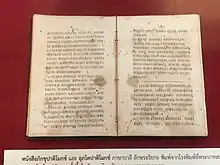| Ariyaka | |
|---|---|
 Bhikkhu Patimokkha in Latin-derived Ariyaka script invented by King Mongkut c. 1841 to write Buddhist texts. | |
| Script type | |
Time period | c. 1800s |
| Direction | left-to-right |
| Region | Thailand |
| Language | Pali |
| Languages | Lao, Isan, and others |
The Ariyaka script (Thai: อักษรอริยกะ) is an obsolete alphabet, invented by King Mongkut as an alternative to transcribing Pali, the liturgical language of Theravada Buddhism. The script, inspired by the Greek and Burmese-Mon scripts, did not come into popular use and eventually fell out of usage.[1]
History
During religious reforms in mid-nineteenth century Rattanakosin Kingdom, King Mongkut discouraged use of the Khom Thai script, which is derived from Khmer, in religious works for reason that its exclusivity gave wrong impression that Khmer script was holy and magical, ordering the monks to switch to the Thai script in recording Buddhist canon. In the 1840s, Mongkut invented the Ariyaka script to promote printing of Tripiṭaka, instead of traditionally inscribing on palm leaf manuscripts.[2][3] The script was adapted from both the Greek and Burmese-Mon scripts, and was intended to supplant other existing scripts for transcribing Pali, including Khom Thai and Tai Tham.[3][4]
References
- ↑ "The Mon Origin of King Rama IV's Ariyaka Script" (PDF). University of Hamburg. 2021.
- ↑ Ghosh, Lipi (2017). India-Thailand Cultural Interactions: Glimpses from the Past to Present. Springer.
- 1 2 Crosby, Kate; Kyaw, Pyi Phyo (2022-10-19). "Practices of Protection in the Pali World". Oxford Research Encyclopedia of Religion. doi:10.1093/acrefore/9780199340378.013.764. Retrieved 2023-03-01.
- ↑ Ray, Himanshu Prabha (2019-01-25), "Archaeology of Buddhism in Asia", Oxford Research Encyclopedia of Asian History, Oxford University Press, doi:10.1093/acrefore/9780190277727.013.214, ISBN 978-0-19-027772-7, retrieved 2023-03-01
External links
![]() Media related to Ariyaka script at Wikimedia Commons
Media related to Ariyaka script at Wikimedia Commons